Winter weather in Alabama is often mild, with decent temperatures and rare cold fronts. Rather than seeing fewer birds during Alabama winters, the area sees an increase as northern breeding birds migrate south.
However, many birds stay in Alabama year-round without migrating to a warmer location. These birds are called non-migratory, and you can view them throughout the winter.
1. Northern Flicker

Northern flickers search for food in trees and on the ground.
©Fiona M. Donnelly/Shutterstock.com
The Northern Flicker is a woodpecker species and the state bird of Alabama. It has a brown body with black spots, a black chest patch, and a red streak on its cheek.
This woodpecker looks for insects to eat on the ground and in trees. They also perch in fruit and berry trees and eat those, too.
2. Mourning Dove

Mourning doves regularly return to their nests to care for their young.
©Brooke Bowdren/Shutterstock.com
These birds are grayish-blue or grayish-brown birds with dark spotted wings and a white tip on their tail. Mourning doves enjoy open spaces but nest nearly 15 feet off the ground.
They prefer open woodlands or forest edges near fields. They eat seeds, grain, insects, and fruit, and you can attract them to your yard by scattering bird seeds. Mourning doves are ground feeders, so you don’t have to worry about filling a bird feeder.
3. Common Grackle

Common grackles have beautiful coloring that doesn’t look like any other bird.
©JoshCW Photo/Shutterstock.com
A common grackle is a blackbird with shades of purple and an iridescent blue head. You’ll find common grackles in open woodlands, especially near pine trees and grassy areas. They also like cultivated fields or open fields with short grass.
Common grackles prefer eating grains, including rice and corn, so you’ll often see them near farmland. However, they also eat fruit, spiders, frogs, fish, garbage, and anything else they can find.
When they visit backyard bird feeders, they are one of the most aggressive. They dominate and take over the bird feeder, chasing other species away.
4. American Kestrel
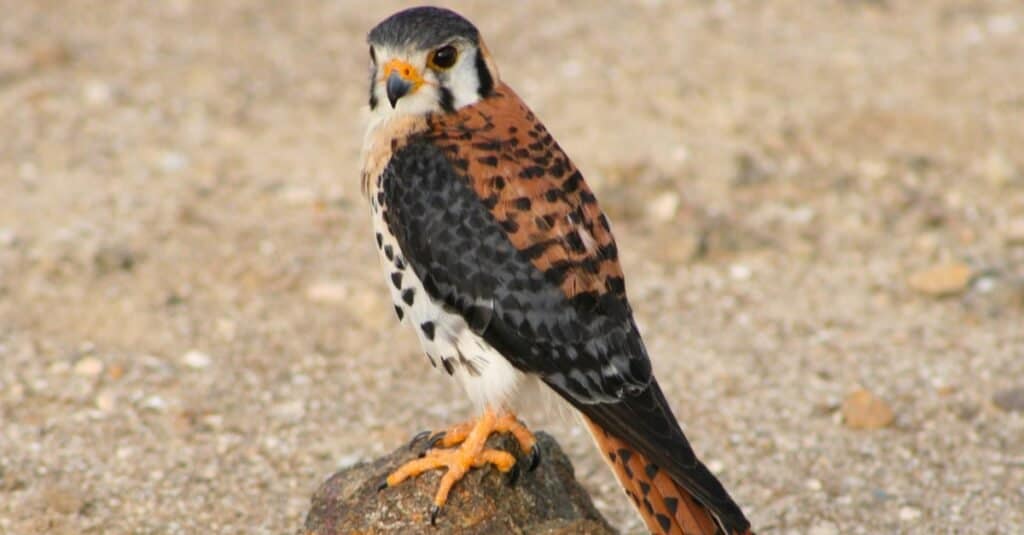
American kestrels are comfortable in different habitats, so you can find them in many locations throughout Alabama.
©Megan M. Weber/Shutterstock.com
You can find American kestrels in Alabama all year in forest clearings, farmland, deserts, or open habitats. Males have a rusty-orange back with a black band and grayish-blue wings, and females have rusty-orange wings, back, and tail. Both sexes have white cheeks and chins with a vertical black line near each eye.
American kestrels prefer spending their time in open fields, deserts, parks, and forest edges. They also need perches for hunting and cavities for nesting, so they’ll often be near trees with holes. If no tree is available, they may opt for small spaces in buildings or artificial nesting boxes.
American kestrels eat wood mice, voles, small birds, earthworms, and insects. They catch their food on the ground or in the air, and they’ll sometimes eat smaller birds.
5. Cedar Waxwing
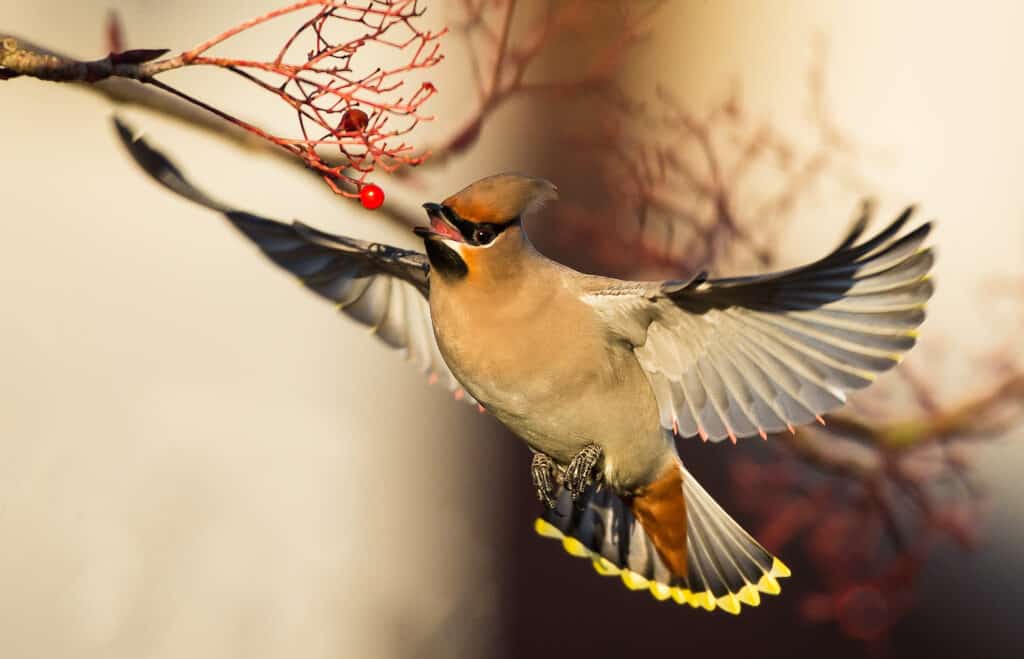
You’ll often see cedar waxwings eating berries from trees and shrubs.
©Paul Tymon/Shutterstock.com
Cedar waxwings have a brown body that fades into gray, a dark strip over their eyes, and bright yellow on the tip of their tail. You’ll also notice that their heads have a crest of feathers, and they have red wing tips.
Cedar waxwings travel in large flocks, looking for berry trees and shrubs in urban landscapes. While they’ll eat many types, their favorite is red cedar berries.
6. Brown-Headed Cowbird
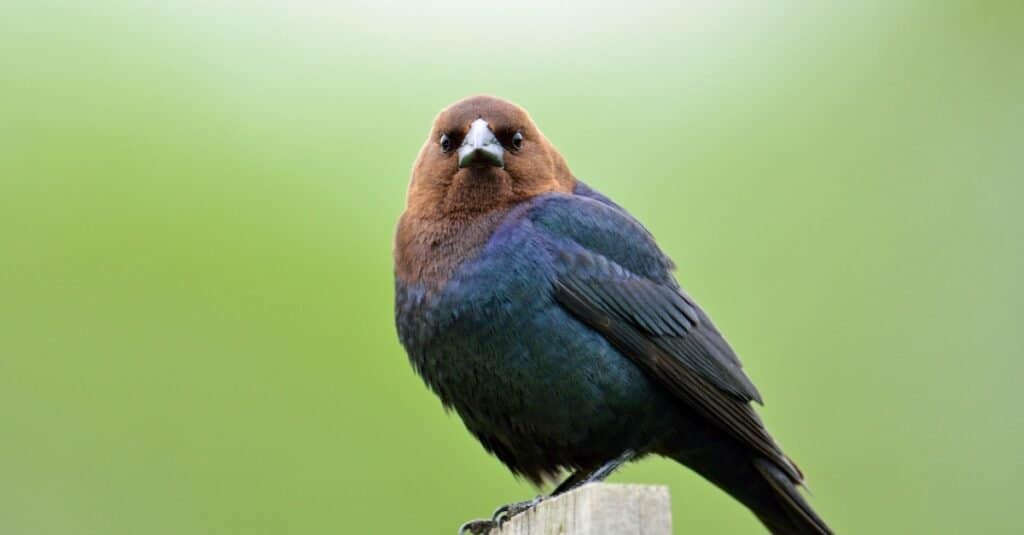
Brown-headed cowbirds lay their eggs in other birds’ nests rather than making their own.
©iStock.com/BrianEKushner
A brown-headed cowbird is a small blackbird. Males have glossy black bodies with brown heads, while females have gray-brown bodies and heads with darker streaks.
You can find brown-headed cowbirds in open spaces, woods, and farmlands. However, if you want, you can attract them to your yard with bird seeds in a bird feeder or scattered on the ground.
Brown-headed cowbirds are aggressive to other birds and may chase off smaller ones. They tend to travel in flocks, so you’ll likely see more than one. These birds don’t build nests, so they lay their eggs in other nests.
7. Eastern Bluebird
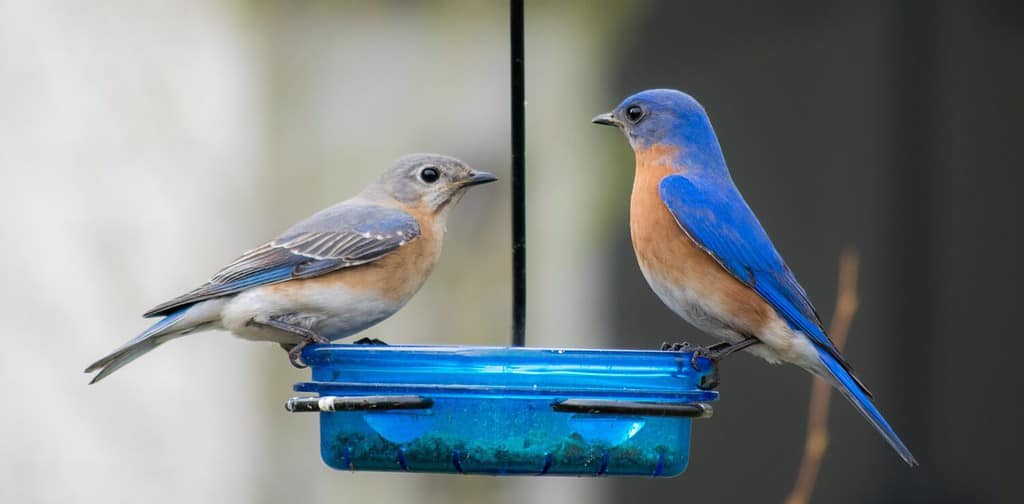
Female eastern bluebirds are lighter in color than males.
©J Zdunczyk/Shutterstock.com
Male eastern bluebirds are deep blue on their head, back, and wings and have a brick-red breast and belly. Females have lighter blue-gray backs with blue wings and tails and golden-colored breast and belly.
Eastern bluebirds enjoy open fields, woodlands, roadsides, and parks. They also like yards with open space, so it’s not hard to attract them by planting shrubs or trees they’ll eat from, including berry bushes, honeysuckle, or other plants.
8. Pileated Woodpecker

Pileated woodpeckers make their nests in holes in trees.
©iStock.com/Harry Collins
The pileated woodpecker has a black body with white stripes on each side of its head. It also has bright red feathers on its head that look like a mohawk.
This woodpecker spends its time near dead trees or downed wood because it eats insects from rotting trees. You won’t often see them in your backyard, but sometimes they appear in suburban areas.
9. Carolina Wren

Wrens prefer eating tiny insects and often search for them in hidden spots in dense vegetation.
©Steve Byland/Shutterstock.com
Carolina wrens have reddish-brown wings and tails with lighter-colored markings all over. Its breast and belly are a lighter brown color and sometimes looks orange. They also have a white stripe above their eyes, almost like eyebrows.
These birds don’t like to be out in the open and tend to hide in dense vegetation. You might only know a Carolina wren is nearby if you hear a loud, varied birdsong.
10. European Starling
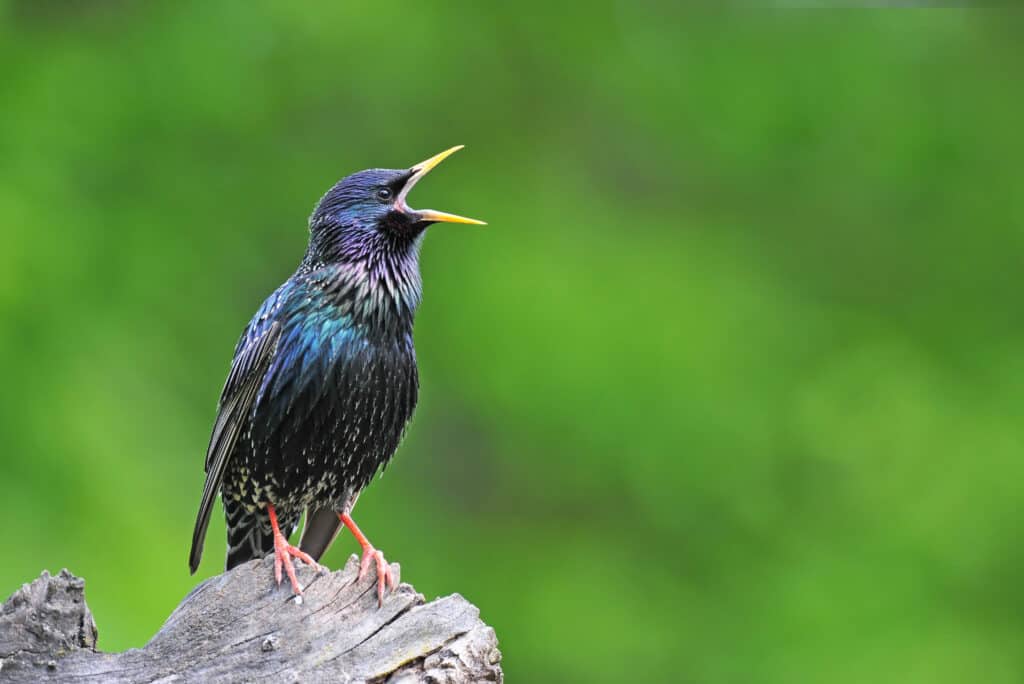
European starlings mimic other bird songs and can also imitate machinery and human speech.
©Soru Epotok/Shutterstock.com
With iridescent purple, shades of green, and cream-colored spots, European starlings are stunning birds. The cream-colored spots typically fade by spring, so you may not always see them. Their bills and wings are pointy, while their tail is square and short.
While European starlings offer a beautiful sight, they are extremely aggressive with other birds. Many people with backyard birdfeeders don’t enjoy seeing them fly into their yard because of it.
11. House Finch
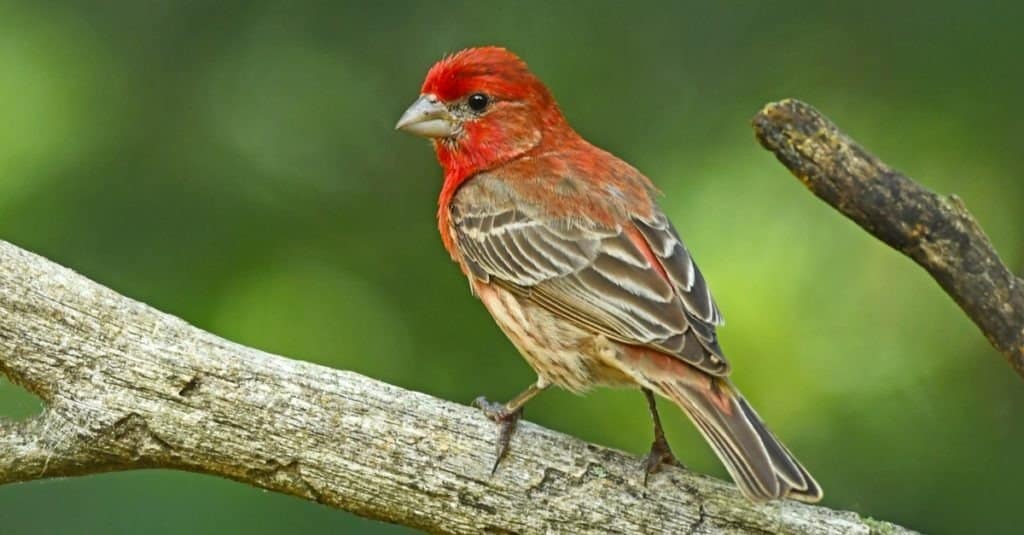
House finches have bright red heads and breasts, making them easily identifiable.
©Brian A Wolf/Shutterstock.com
A male house finch has a gray-brown body with a red head and breast. The females have the same color body as males, but their back, belly, and breast are streaked with black and their head isn’t red.
House finches build their nests in trees, cacti, and rock ledges, but you also may find their nests in light fixtures, hanging planters, and outdoor home décor. They enjoy outdoor bird feeders, so they might make their home near your yard if you have one.
12. American Goldfinch
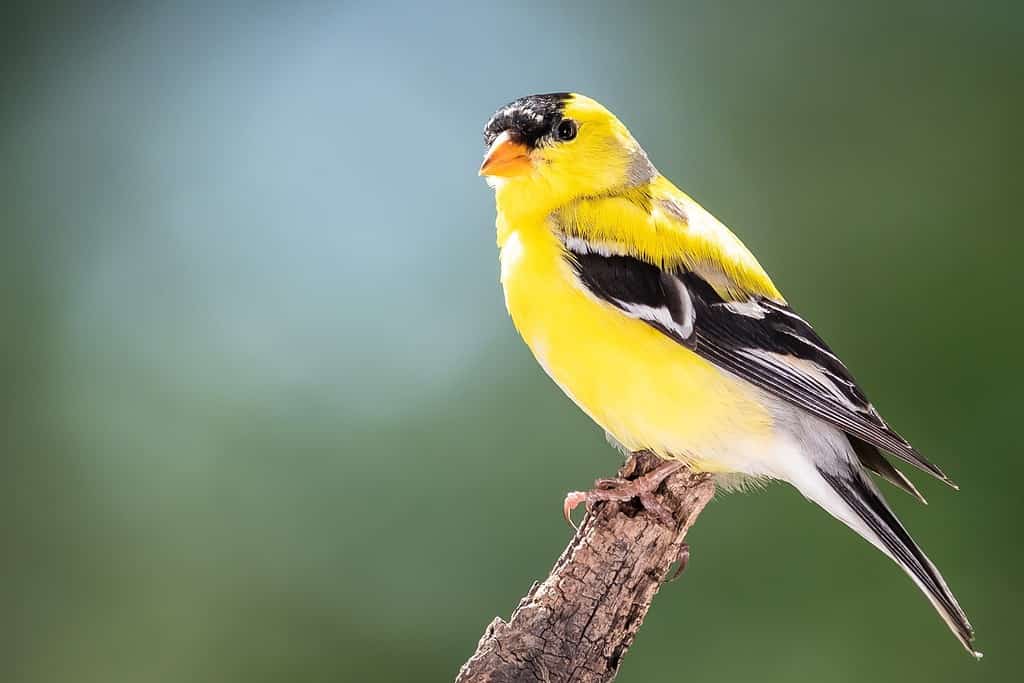
An American goldfinch is bright yellow, making it stand out amongst other birds.
©rck_953/Shutterstock.com
These finches have a yellow body, black and white wings, and a black patch on their forehead. Female American goldfinches aren’t as vibrant, but you can see hints of the coloring on a mostly light brown body.
They prefer spending their time at the edges of forests and plains. Scope out spots filled with thistle plants and brush if you’d like to find them.
13. American Robin
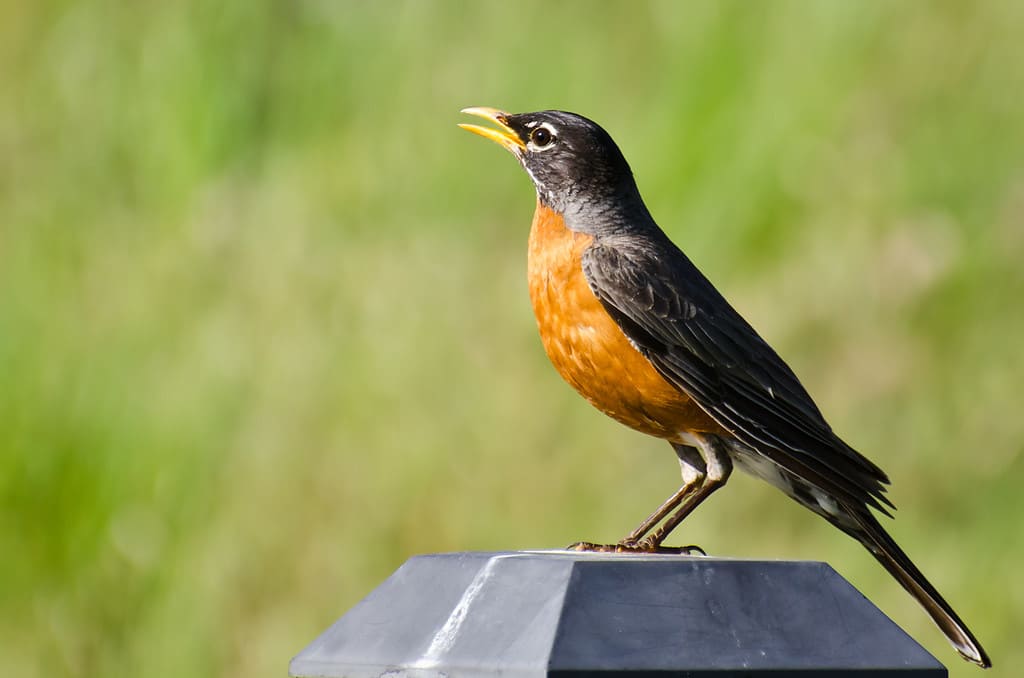
American robins often visit backyard bird feeders and perch on outdoor lights or other things in your yard.
©RCKeller/iStock via Getty Images
When looking for an American Robin, you want to watch for a bird with a gray back, wings and tail, black head, yellow bill, and an orange breast. These birds prefer open spaces, woodlands, parks, backyards, and grasslands.
14. Pine Warbler
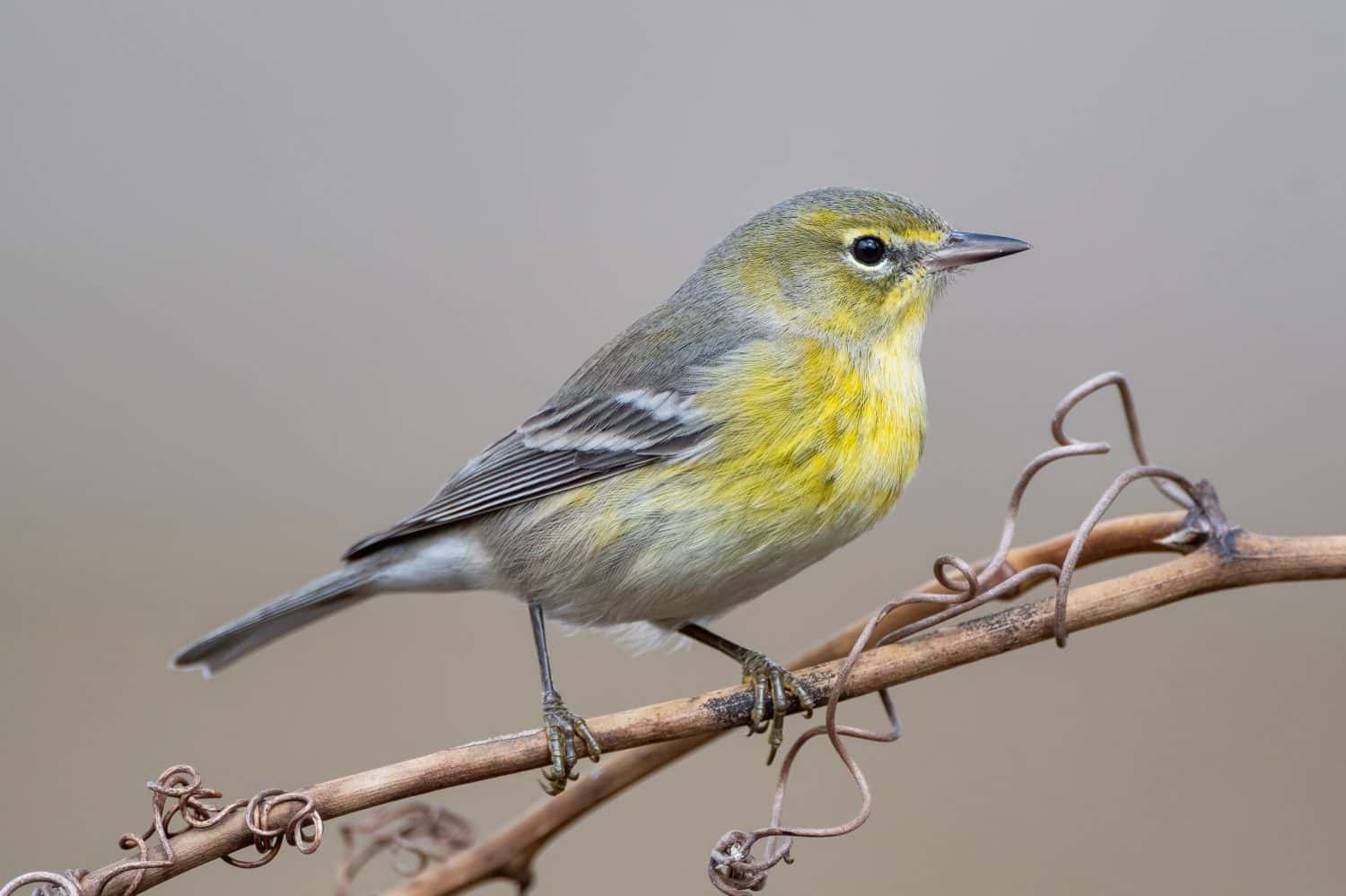
Pine warblers spend their time near pine trees, and you’re unlikely to see them elsewhere.
©Bonnie Taylor Barry/Shutterstock.com
These birds have yellow bodies, bellies, and heads, and their wings are striped with gray and white. Female and immature pine warblers have duller colors, with almost grayish-brown bodies.
Pine warblers enjoy pine woodlands and won’t venture far outside those areas. If you live near pine trees, you can attract the birds by putting bird seeds out for them. Otherwise, they look for insects or seeds on the ground.
15. Red-Winged Blackbird
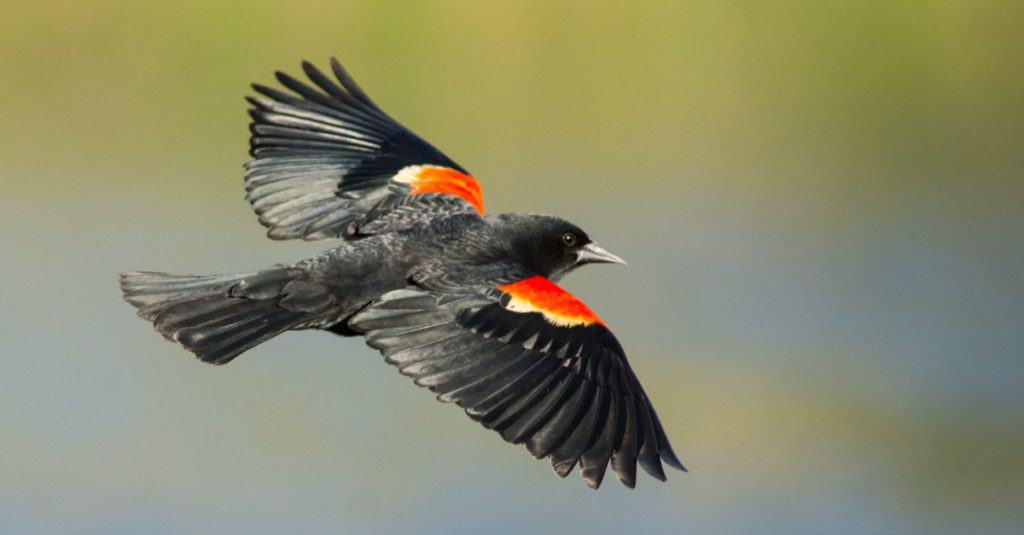
When you see a red-winged blackbird, the bright red patches on their shoulders stand out.
©JoshCW Photo/Shutterstock.com
Red-winged blackbirds vary in color, with females being brown and having black streaks and adult breeding and non-breeding males having different appearances. The adult breeding males are black and have bright red patches on their shoulders. The non-breeding birds have rusty-colored wing edges during winter months and don’t have shoulder patches.
You can see red-winged blackbirds in your backyard if you live near marshes, farmland, or lakes. They typically eat grains and seeds but sometimes also eat insects, berries, and small animals. Red-winged blackbirds seek out bird feeders but sometimes become aggressive with other birds.
16. Eastern Towhee

Eastern towhees have red eyes, which sets them apart from other bird species.
©John L. Absher/Shutterstock.com
Male eastern towhees have a black hood and back while females have brown. They both have a white belly and orangish-brown sides. You can find towhees in areas with dense low vegetation, and they nest in undergrowth or leaf accumulation on the ground.
If you want to attract them to your yard, scatter bird seeds around your yard. They prefer eating from the ground, so they’ll take what’s there before going to the feeder.
Where to see Birds That Spend Their Winters in Alabama

Dauphin Island, AL, is one of the best places in the state to watch birds.
©George Dodd III/Shutterstock.com
Alabama has many birding trails to visit public lands for bird watching. With 280 sites, there are places all over the state, so there’s sure to be one in the area you live in or are visiting.
Alabama has many other birdwatching hot spots throughout the state, and you can explore various habitats to see different birds. You can see a nice variety of birds that spend their winters in Alabama at two favorite locations of birders, Lakepoint State Park and Dauphin Island.
If you want to see ducks, unmentioned above, but they are birds that spend their winters in Alabama, you can visit the Wheeler National Wildlife Refuge. You can watch ducks through an enclosed viewing building that provides a close look. A microphone mounted in the pond area allows you to hear the ducks, giving you the feel of being in their natural environment.
Summary of Birds That Spend Their Winters in Alabama
| Number | Birds That Spend Their Winters in Alabama |
| 1 | Northern flicker |
| 2 | Mourning dove |
| 3 | Common grackle |
| 4 | American kestrel |
| 5 | Cedar waxwing |
| 6 | Brown-headed cowbirds |
| 7 | Eastern bluebirds |
| 8 | Pileated woodpecker |
| 9 | Carolina wren |
| 10 | European starling |
| 11 | House finch |
| 12 | American Goldfinch |
| 13 | American robin |
| 14 | Pine Warbler |
| 15 | Red-winged blackbird |
| 16 | Eastern towhees |
The photo featured at the top of this post is © JoshCW Photo/Shutterstock.com
Thank you for reading! Have some feedback for us? Contact the AZ Animals editorial team.






